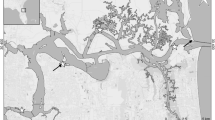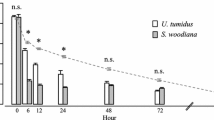Abstract
Moon jellyfish Aurelia aurita s.l. has been suggested to have high mortality during the ephyra stage, which potentially affects the population size of the later medusa stage. However, the mechanism behind the high mortality rate has still not been clarified. Ephyrae of A. aurita are liberated from the sessile strobila, which are usually surrounded by filter-feeding sessile organisms. In the present study, we carried out a series of feeding trials at 10 °C, offering A. aurita ephyrae to three potential predatory filter-feeding sessile organisms: the mussel Mytilus galloprovincialis, the ascidian Styela plicata, and the barnacle Amphibalanus eburneus. From the experiments, the mussel was estimated to have the highest ability to consume ephyrae among the sessile organisms. Size-selective filtration experiments showed that the mussel consumed newly liberated ephyrae [3 mm total body diameter (TBD)] at a significantly higher efficiency than larger (5 and 7 mm TBD) ephyrae. Our results demonstrate that filter-feeding sessile organisms, especially the mussel, are potential consumers of the early ephyra stage.





Similar content being viewed by others
References
Huntley ME, Hobson LA (1978) Medusa predation and plankton dynamics in a temperate fjord, British Columbia. J Fish Res Board Can 35:257–261
Möller H (1984) Reduction of a larval herring population by jellyfish predator. Science 224:621–622
Condon RH, Steinberg DK, del Giorgio PA et al (2011) Jellyfish blooms result in a major microbial respiratory sink of carbon in marine systems. Proc Natl Acad Sci USA 108:10225–10230
Lebrato M, Pitt KA, Sweetman AK et al (2012) Jelly-falls historic and recent observations: a review to drive future research directions. Hydrobiologia 690:227–245
Purcell JE (2012) Jellyfish and ctenophore blooms coincide with human proliferations and environmental perturbations. Ann Rev Mar Sci 4:209–235
Condon RH, Duarte CM, Pitt KA et al (2013) Recurrent jellyfish blooms are a consequence of global oscillations. Proc Natl Acad Sci USA 110:1000–1005
Purcell JE, Uye S, Lo W-T (2007) Anthropogenic causes of jellyfish blooms and their direct consequences for humans: a review. Mar Ecol Prog Ser 350:153–174
Gibbons MJ, Richardson AJ (2013) Beyond the jellyfish joyride and global oscillations: advancing jellyfish research. J Plankton Res 35:929–938
Dawson MN, Martin LE (2001) Geographic variation and ecological adaptation in Aurelia (Scyphozoa, Semaeostomeae): some implications from molecular phylogenetics. Hydrobiologia 451:259–273
Uye S, Fujii N, Takeoka H (2003) Unusual aggregations of the scyphomedusa Aurelia aurita in coastal waters along western Shikoku, Japan. Plankton Biol Ecol 50:17–21
Pagès F (2001) Past and present anthropogenic factors promoting the invasion, colonization and dominance by jellyfish of a Spanish coastal lagoon. In: Briand F (ed) Gelatinous zooplankton outbreaks: theory and practice. CIESM Workshop series 14. CIESM, Monaco, pp 59–71
Zaitsev Y, Mamaev V (1997) Biological diversity in the Black Sea: a study of change and decline. United Nations, New York
Kogovšek T, Bogunović B, Malej A (2010) Recurrence of bloom-forming scyphomedusae: wavelet analysis of a 200-year time series. Hydrobiologia 645:81–96
Uye S (2011) Human forcing of the copepod–fish–jellyfish triangular trophic relationship. Hydrobiologia 666:71–83
Dong Z, Liu D, Keesing JK (2010) Jellyfish blooms in China: dominant species, causes and consequences. Mar Pollut Bull 60:954–963
Liu W-C, Lo W-T, Purcell JE, Chang H-H (2009) Effects of temperature and light intensity on asexual reproduction of the scyphozoan, Aurelia aurita (L.) in Taiwan. Hydrobiologia 616:247–258
Han C-H, Uye S (2010) Combined effects of food supply and temperature on asexual reproduction and somatic growth of polyps of the common jellyfish Aurelia aurita s.l. Plankton Benthos Res 5:98–105
Willcox S, Moltschaniwskyj NA, Crawford CM (2008) Population dynamics of natural colonies of Aurelia sp. scyphistomae in Tasmania, Australia. Mar Biol 154:661–670
Thein H, Ikeda H, Uye S (2012) The potential role of podocysts in perpetuation of the common jellyfish Aurelia aurita s.l. (Cnidaria: Scyphozoa) in anthropogenically perturbed coastal waters. Hydrobiologia 690:157–167
Kakinuma Y (1975) An experimental study of the life cycle and organ differentiation of Aurelia aurita Lamarck. Bull Mar Biol Stn Asamushi 15:101–112
Custance DRN (1964) Light as an inhibitor of strobilation in Aurelia aurita. Nature 204:1219–1220
Fu Z, Shibata M, Makabe R et al (2014) Body size reduction under starvation, and the point of no return, in ephyrae of the moon jellyfish Aurelia aurita. Mar Ecol Prog Ser 510:255–263
Ishii H, Kojima S, Tanaka Y (2004) Survivorship and production of Aurelia aurita ephyrae in the innermost part of Tokyo Bay, Japan. Plankton Biol Ecol 51:26–35
Fuiman LA, Werner RG (2002) Fishery science: the unique contribution of early life stages. Blackwell Science, Oxford
Paschke KA, Gebauer P, Buchholz F, Anger K (2004) Seasonal variation in starvation resistance of early larval North Sea shrimp Crangon crangon (Decapoda: Crangonidae). Mar Ecol Prog Ser 279:183–191
Cargo DG, Schultz LP (1967) Further observations on the biology of the sea nettle and jellyfishes in Chesapeake Bay. Chesapeake Sci 8:209–220
Makabe R, Furukawa R (2014) Marine artificial structures as amplifiers of Aurelia aurita s.l. blooms: a case study of a newly installed floating pier. J Oceanogr 70:447–455
Miyake H, Terazaki M, Kakinuma Y (2002) On the polyps of the common jellyfish Aurelia aurita in Kagoshima Bay. J Oceanogr 58:451–459
Straehler-Pohl I, Jarms G (2010) Identification key for young ephyrae: a first step for early detection of jellyfish blooms. Hydrobiologia 645:3–21
Fujiwara S, Akima C, Nogata Y et al (2013) Bio-organic and anti-barnacle studies of fluorescence-labeled probe compounds against cyprids of barnacles. J Exp Mar Biol Ecol 445:88–92
Toyokawa M, Aoki K, Yamada S et al (2011) Distribution of ephyrae and polyps of jellyfish Aurelia aurita (Linnaeus 1758) sensu lato in Mikawa Bay, Japan. J Oceanogr 67:209–218
Harrison PJ, Conway HL, Holmes RW, Davis CO (1977) Marine diatoms grown in chemostats under silicate or ammonium limitation. III. Cellular chemical composition and morphology of Chaetoceros debilis, Skeletonema costatum, and Thalassiosira gravida. Mar Biol 43:19–31
Uye S, Kayano Y (1994) Predatory feeding behavior of Tortanus forcipatus on three different prey. Bull Plankton Soc Japan 40:173–176
Coughlan J (1969) The estimation of filtering rate from the clearance of suspensions. Mar Biol 2:356–358
Sokal RR, James FR (1995) Biometry: the principles and practice of statistics in biological research, 3rd edn. Freeman, New York
Bailey KM, Houde ED (1989) Predation on eggs and larvae of marine fishes and the recruitment problem. Adv Mar Biol 25:1–83
Rumrill SS (1990) Natural mortality of marine invertibrate larvae. Ophelia 32:163–198
Fuiman LA, Cowan JHJ, Smith ME, O’Neal JP (2005) Behavior and recruitment success in fish larvae: variation with growth rate and the batch effect. Can J Fish Aquat Sci 62:1337–1349
Fuiman LA, Cowan JHJ (2003) Behavior and recruitment success in fish larvae: repeatability and covariation of survival skills. Ecology 84:53–67
Kim YS, Moon TS (1998) Filtering rate with effect of water temperature and size of two farming ascidians Styela clava and S. plicata, and a farming mussel Mytilus edulis. J Korean Fish Soc 31:272–277 (in Korean with English abstract)
van Erkom Schurink C, Griffiths CL (1992) Physiological energetics of four South African mussel species in relation to body size, ration and temperature. Comp Biochem Physiol 101A:779–789
Fiala-Médioni A (1978) Filter-feeding ethology of benthic invertebrates (ascidians). III. Recording of water current in situ—rate and rhythm of pumping. Mar Biol 45:185–190
Ren JS, Ross AH, Schiel DR (2000) Functional descriptions of feeding and energetics of the Pacific oyster Crassostrea gigas in New Zealand. Mar Ecol Prog Ser 208:119–130
Bougrier S, Geairon P, Jonquikres G, Bather C (1995) Allometric relationships and effects of temperature on clearance and oxygen consumption rates of Crassostrea gigas (Thunberg). Aquaculture 134:143–154
Randløv A, Riisgård HU (1979) Efficiency of particle retention and filtration rate in four species of ascidians. Mar Ecol Prog Ser 1:55–59
Sullivan BK, Suchman CL, Costello JH (1997) Mechanics of prey selection by ephyrae of the scyphomedusa Aurelia aurita. Mar Biol 130:213–222
Riisgård HU, Jørgensen BH, Lundgreen K et al (2011) The exhalant jet of mussels Mytilus edulis. Mar Ecol Prog Ser 437:147–164
Wang N, Li C (2015) The effect of temperature and food supply on the growth and ontogeny of Aurelia sp. 1 ephyrae. Hydrobiologia 754:157–167
Kuplik Z, Kerem D, Angel DL (2015) Regulation of Cyanea capillata populations by predation on their planulae. J Plankton Res 37:1068–1073
Lo W-T, Purcell JE, Hung J-J et al (2008) Enhancement of jellyfish (Aurelia aurita) populations by extensive aquaculture rafts in a coastal lagoon in Taiwan. ICES J Mar Sci 65:453–461
Lo WT, Chen IL (2008) Population succession and feeding of scyphomedusae, Aurelia aurita, in a eutrophic tropical lagoon in Taiwan. Estuar Coast Shelf Sci 76:227–238
Ishii H, Katsukoshi K (2010) Seasonal and vertical distribution of Aurelia aurita polyps on a pylon in the innermost part of Tokyo Bay. J Oceanogr 66:329–336
Acknowledgments
We especially thank Ms. E. Yoshimura, Ms. K. Sato, Dr. T. Yoshimura and Dr. Y. Nakane for their cooperation with the laboratory experiments, Dr. M. Tomita for helpful advice on the statistical analysis, Mr. T. Yamashita, Mr. A. Yasuda, Mr. Y. Murata, and Mr. Y. Takami for helping with the sample collection and field observations, and Dr. M. L. Walsh for editing the English. We are also grateful to two anonymous reviewers for helpful comments that improved the manuscript.
Author information
Authors and Affiliations
Corresponding author
Rights and permissions
About this article
Cite this article
Suzuki, K.S., Kumakura, E. & Nogata, Y. Incidental consumption of ephyrae of moon jellyfish Aurelia aurita s.l. by three filter-feeding sessile organisms: laboratory experiments. Fish Sci 82, 923–930 (2016). https://doi.org/10.1007/s12562-016-1034-4
Received:
Accepted:
Published:
Issue Date:
DOI: https://doi.org/10.1007/s12562-016-1034-4




